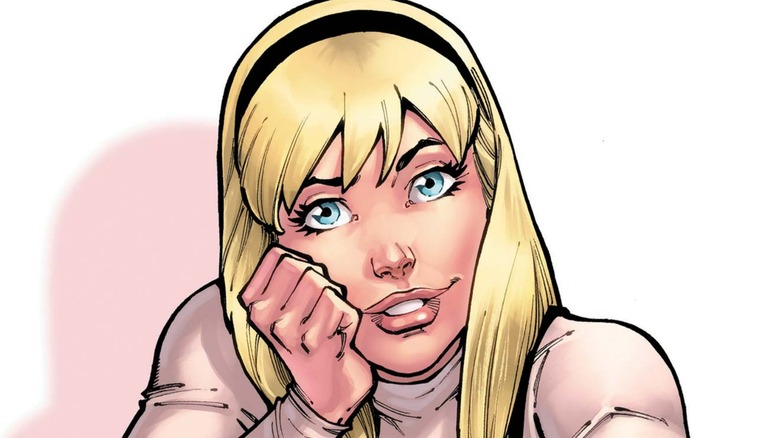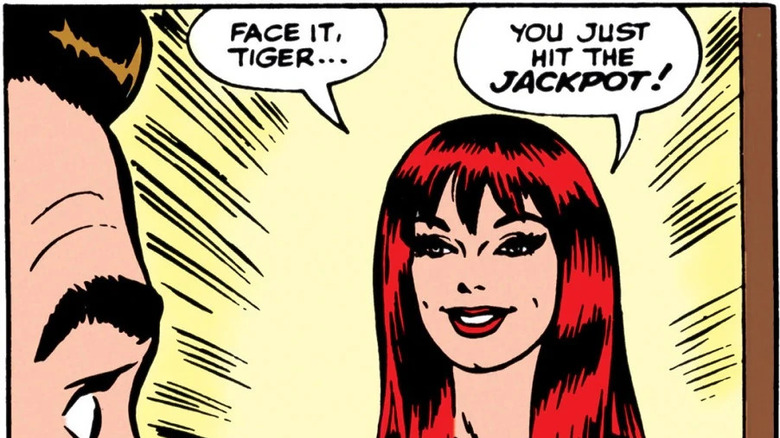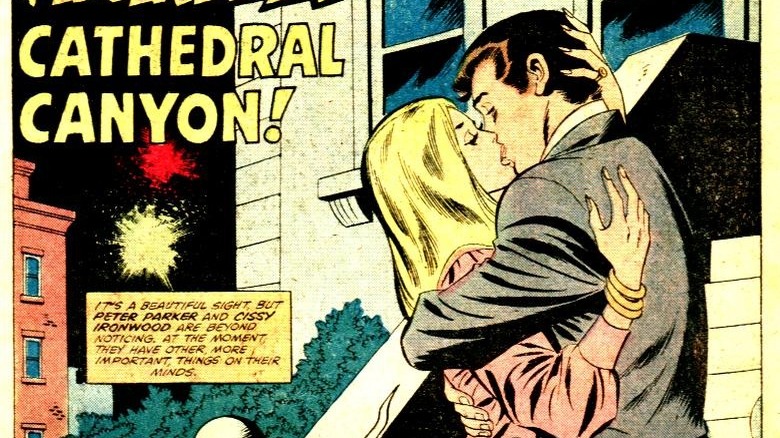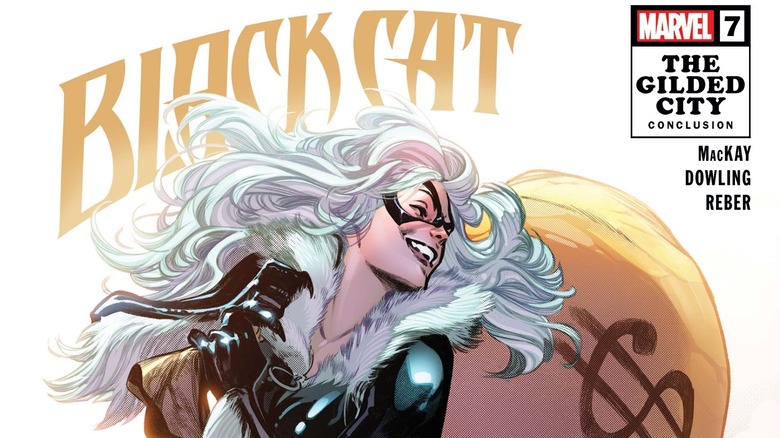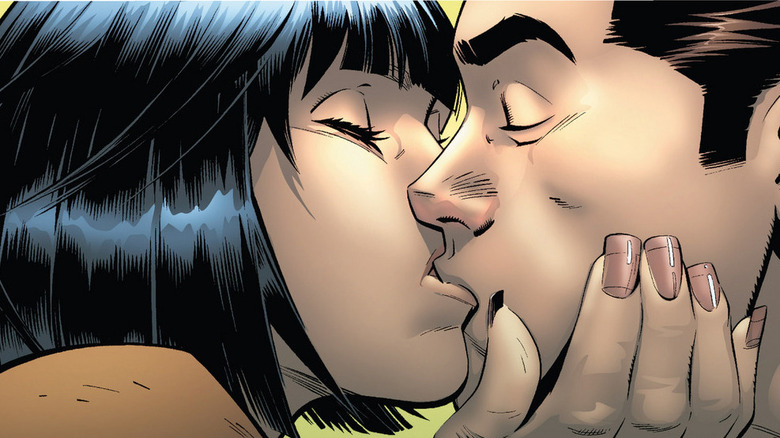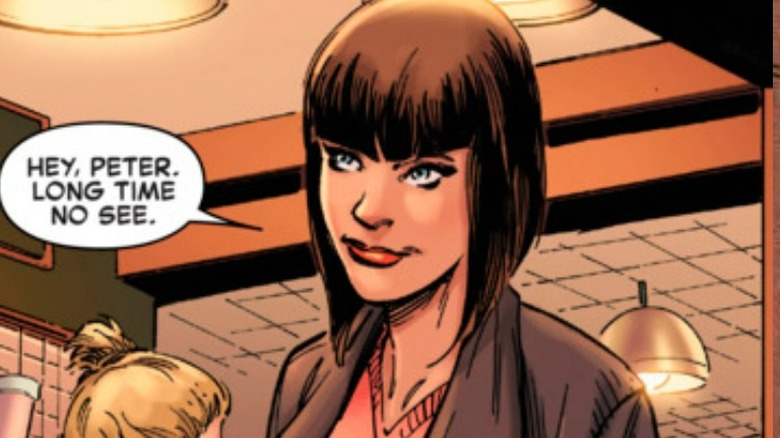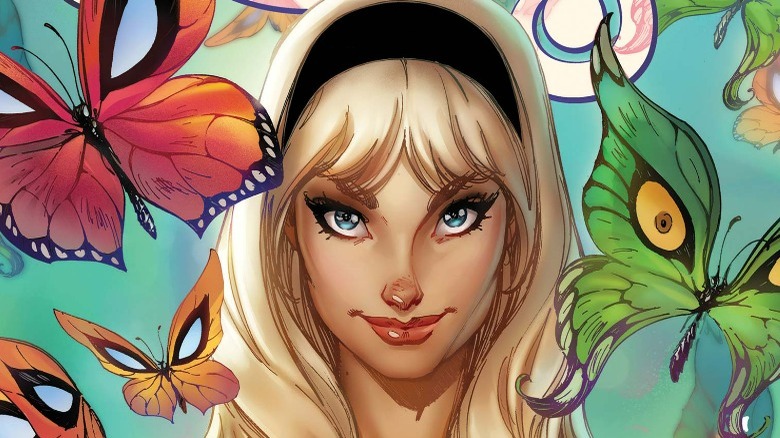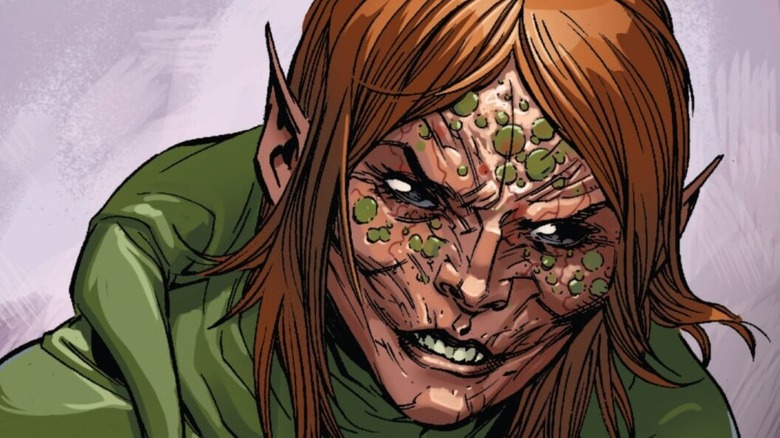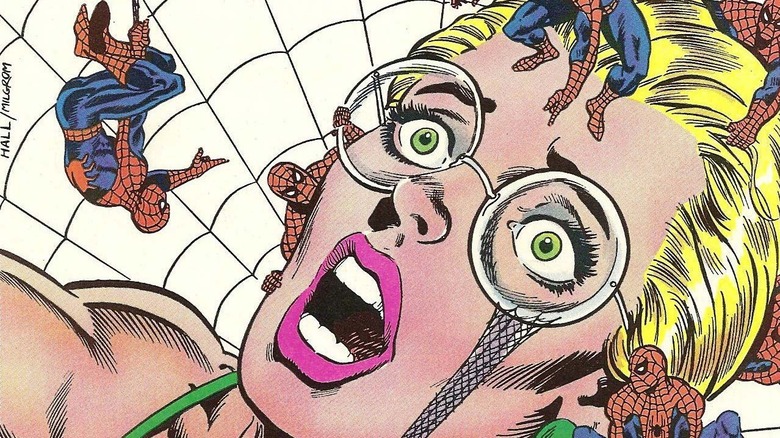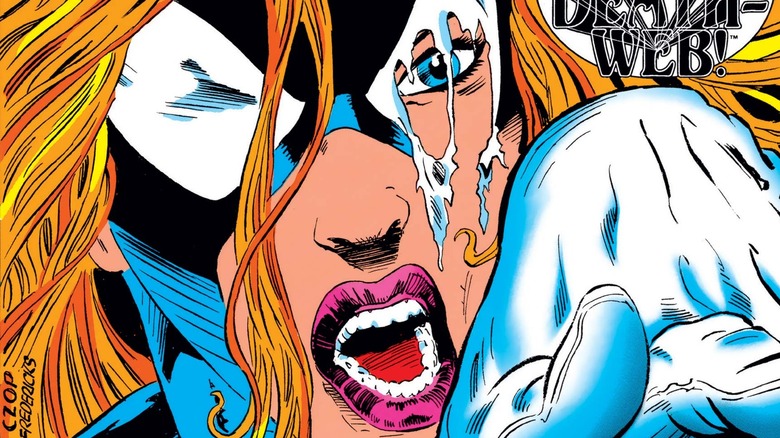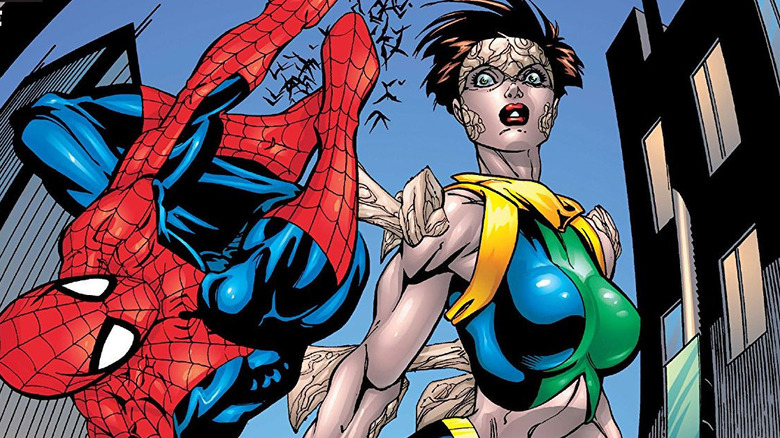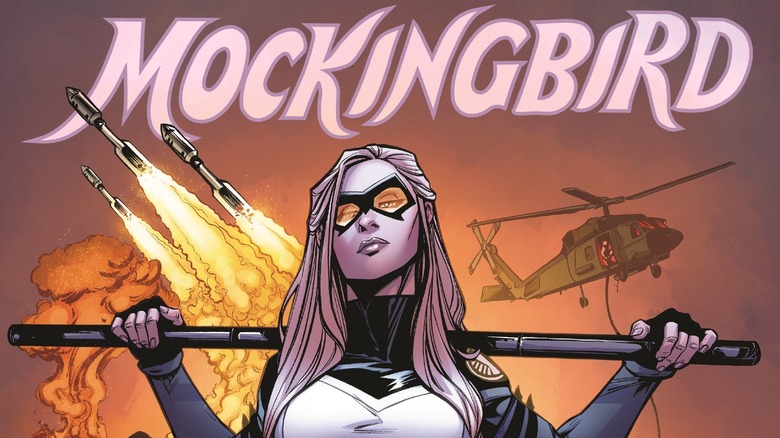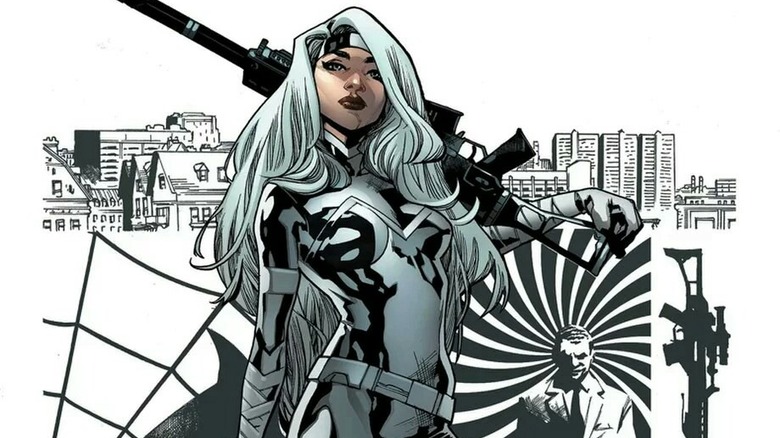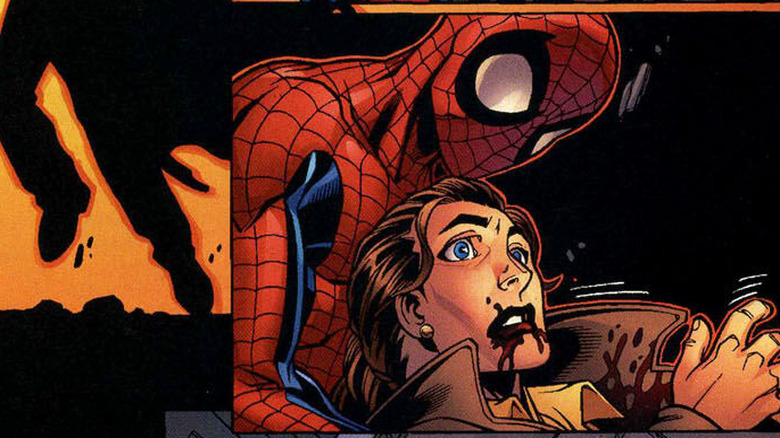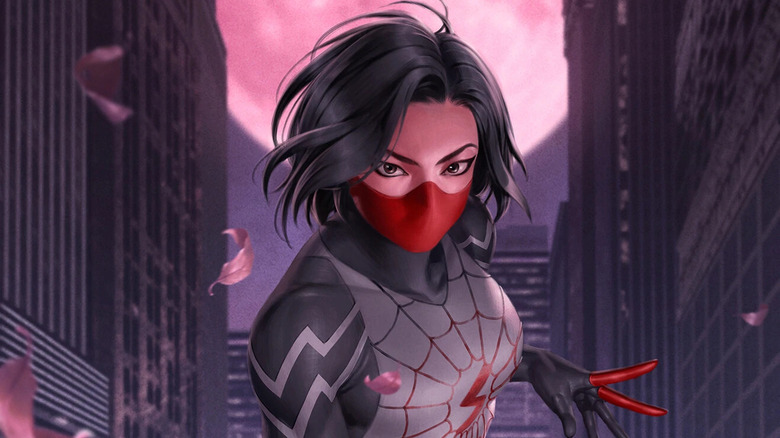All Of Spider-Man's Love Interests Explained
We may receive a commission on purchases made from links.
Peter Parker first swinged into pop culture as Spider-Man in 1962's "Amazing Fantasy" #15. Since then, Spider-Man has gone on to become one of the most popular superheroes in the genre and one of the most popular fictional characters in the world. A key to the character's success is that his creators, Stan Lee and Steve Ditko, developed a deep personal life for Parker. This meant that readers got to know about Parker's schooling, his work, his family, and even his love life.
Parker's love life has become such a cornerstone of the Spider-Man franchise that his relationships with two of his girlfriends was explored by Jeph Loeb and Tim Sale in a six-part mini-series called "Spider-Man: Blue." Let's take a bit to reflect on all the women Parker has been romantically associated with, from Mary Jane to Gwen to Cindy Moon.
Mary Jane Watson
"Face it, Tiger. You just hit the jackpot," are the eight words Mary Jane Watson said to Peter Parker when she was first introduced to him in "Amazing Spider-Man" #42. Since this appearance in 1966, Mary Jane — more commonly referred to as MJ — has become Parker's main romance partner.
Interestingly, MJ wasn't initially portrayed as Parker's endgame romance. While Gwen Stacy was the respectable daughter of a police officer, MJ was originally seen as more of a bad girl — at least by the standards of the 1960s. Though Parker did date her, he would eventually end the relationship to begin one with Stacy. It is only after Stacy dies that Parker and MJ form an emotionally healthy friendship, one that evolves into romance.
This relationship would culminate in the two getting married in "The Amazing Spider-Man Annual" #21. Sadly, while the issue ends with the promise of a 'happily ever after,' this marriage would be undone decades later during the "One More Day" arc. After making a deal with Marvel's version of the Devil, Mephisto, to restore life to Aunt May, time is changed so that Parker and MJ are never married. This deal also restores Spider-Man's secret identity after he had revealed it to the public during the Civil War story.
Though this marriage was retconned out of existence in 2007/2008 and has yet to be undone, MJ remains Parker's most popular love interest.
Cissy Ironwood
Cissy Ironwood first appeared in 1979's "Marvel Team-Up" #80 and only made minor appearance is four other issues. Created by Mike Vosburg and Chris Claremont, the character seemed to have been created just to be a generic girlfriend — one that Parker could have without Claremont having to worry about Parker's more popular partners. Also, with Gwen Stacy having died in 1973, but the wedding to MJ not taking place until 1987, it seems that Ironwood functions as an in-between relationship.
Of additional note, is that with blond hair and a petite frame, Ironwood is depicted visually similar go Gwen Stacy; a creative decision that has never been discussed. Beyond that, readers are told how Parker and Ironwood began dating nor do writers ever explain why this relationship ended. Ending on a fun place, Ironwood is depicted as being one of several women who have a crush on the Beast.
Felicia Hardy aka Black Cat
The Black Cat, a cat burglar who vacillates between villain and antihero, is the classic example of the girl you shouldn't take home to meet your parents. While Black Cat and Spider-Man have both known one another as Felicia Hardy and Peter Parker for years, a key element of their relationship is that Hardy prefers Spider-Man over Peter Parker. Hardy finds a sense of freedom in mainly being the Black Cat and struggles to understand why Parker refuses to do the same. A unique element of Black Cat is how she is framed against MJ. As MJ became the stable romantic figure in Parker's life (a place initially occupied by Stacy), Black Cat became positioned as a temptress.
An extension of this, their relationship has largely been based on secrets. As Tim Stevens wrote for Marvel.com, "When Peter Parker revealed himself to be the one and only Friendly Neighborhood Spider-Man live on television, Felicia Hardy could not help but take it personally. As one of the first people he ever revealed his identity to and still one of the few who knew it, she had felt special, as though he trusted her in a way he trusted few others. However, if he could tell the world, well, maybe their friendship had not been as special as she assumed."
Basically, while Parker dreams of a normal life, the Black Cat wants every aspect of her life to be as thrilling as fighting crime or stealing something priceless. With that said, it appears that the jealousy between Black Cat and MJ has evolved into mutual respect.
Anna Maria Marconi
Created by Dan Slott and Giuseppe Camuncoli, Anna Maria Marconi was introduced as Parker's physics tutor when he went back to Empire State University to finish his doctorate. In addition to Marconi being one of the few little people in comics, but she is never presented as any of the stereotypes associated with little people in fiction.
She begins a relationship with Parker when his body was controlled by Dr. Otto Octavius. This was during the "Superior Spider-Man," and it was interesting to see how Doc Ock pursued a relationship differently from Parker. When she learned that Otto had taken over Parker's body, she was upset over the moral implications of that crime, while also acknowledging that Otto had changed for the better.
Marconi is not as prominent of a character as she once was, but the foundation has been laid for her to be a long lasting figure in the Spider-Verse.
Betty Brant
Reflecting on the history of Betty Brant creates an interesting contrast between how Marvel Comics officially views the character versus how she was actually treated in the comics. A 2019 article from Marvel.com examining the women in Spider-Man's life describes Brant in the following way: "At the Daily Bugle, Betty Brant helped take care of Peter's career as a photographer by ensuring he got the checks he deserved when J. Jonah Jameson tried to be stingy. Without Betty, Peter couldn't buy supplies for web fluid, food, or even pay his rent. Peter also briefly dated Betty, but more importantly, Peter's professional life depended on her."
While Marvel now isolates her to professional connection to Parker via his Daily Bugle work, Betty would have a turbulent relationship with Parker. She blames Spider-Man for the death of her brother. She ends up marrying another man, only to date Parker again after she divorces him. Her life becomes filled with so much stress that she has a mental breakdown, then joins a cult, and then leaves the cult to become a vigilante. So, yeah, there's a lot going on with Brant.
Gwen Stacy
Depending on which fan you ask, Gwen Stacy is either Parker's one-true-love or she is second only to Mary Jane. Either way, Gwen Stacy has evolved from a girlfriend to a damsel in distress to a woman in the refrigerator to (thanks to the multiverse) a hero in her own right. First appearing in 1965's "The Amazing Spider-Man," and created by Stan Lee and Steve Ditko, Gwendolyne Maxine Stacy was Parker's first girlfriend after he left high school. More than just physically attractive, Stacy was also a interested in the sciences an interest that she and Parker bonded over. Also, Parker was liked by Stacy's father, who encouraged his daughter to date Parker.
Before Stacy even made it to a decade in the comics, Marvel decided to kill her off. Ultimately, her afterlife would be one of the more interesting. The character would initially come back as a clone, only for those clones to be written off or destroyed. There was even an alternate reality story called "House of M" that brought Stacy back as Parker's true love.
However, the greatest moment of Stacy's legacy was the creation of an alternate reality version that was bitten by a radioactive spider instead of Parker. This version would go on to be called Spider-Gwen and the Ghost Spider.
In regards to Parker, though he knows a version of Stacy is still around, he still thinks of his Stacy as the love that got away.
Carlie Cooper
After "One More Day" erased Parker's and MJ's marriage, fans wondered how this would impact Parker's love life. With "Brand New Day," they got to see what Parker's dating life would be with the introduction of Carlie Cooper — a character created in 2007 by Dan Slott and Joe Quesada. Friends with Gwen Stacy, Cooper is a New York Police Department's Crime Scene Unit officer. Her first arc kicks off when she finds a spider-tracer on a dead body, a discovery that leads to her learning about an anti-Spider-Man conspiracy.
After a period of time spent in Parker's orbit, the two finally started dating. Cooper, sadly, became the standard superhero girlfriend — she's kidnapped by a villain, and eventually left Parker because she couldn't handle his superhero identity. Over time, Cooper's importance to the main characters had dropped so much that she was kidnapped and no one really noticed. Currently, Cooper seems less focused on Parker and more focused on a support group for people who have been in relationships with superheroes.
Debra Whitman
First appearing in 1979, and created by Marv Wolfman and Al Milgrom, Debra Whitman only had a short romance with Parker, but it evolved into a unique story arc. According to Marvel.com's overview of Parker's girlfriends, Whitman is summarized as such: "Hardcore Spider fans will remember Debra Whitman; while Peter's lab partner at Empire State University, Debra wowed Peter with her brains and beauty. An ill-fated romance ensued when Debra became sick of Peter's lame excuses."
Whitman would be one of the few women in Parker's life to develop mental health issues. While her depiction of mental health problems did not age well, the character would go on to blame Spider-Man for much of her problems. When Parker reveals to her that he is Spider-Man, an act he hopes will help, Whitman was furious and published a book titled "TWO FACED: How Spider-Man Ruined My Life." Parker revealing that he is Spider-Man to the world during "Civil War" only further harmed Whitman. However, the character would last appear in 2007, in which she admitted that she had overstated her anti-Spider-Man claims. After this, it appears that her connection to Parker was erased after he made a deal with the devil.
Julia Carpenter
Julia Carpenter is one of the few romantic partners of Spider-Man that has benefited from tremendous growth in her own right. Created by Jim Shooter and Mike Zeck, Carpenter first appeared in June 1984 as Spider-Woman. Years later, she would adopt the name Arachne, before becoming the new Madame Web.
Carpenter's romantic relationship with Parker is largely limited to flirting and a close friendship. She even made him a non-symbiote version of his black costume. Interestingly, as mentioned on page 343 of the Marvel Encyclopedia, Carpenter's first costume was black and was initially presented as the outfit that inspired Parker's symbiote costume to be black. (Though this would be changed in later retcons.)
She is also one of the few women Parker meets that has the maturity to not put up with his faults. In addition to having already been college educated, married, and a parent, Carpenter was selected by a government agency for an experiment that gave Carpenter her powers. By the time Carpenter meets Parker in "Secret Wars," she isn't immediately star struck.
Liz Allan
Most people learned about Liz Allan from the character's appearance in "Spider-Man: Homecoming," in which Laura Harrier portrayed her. While Allan has only appeared in the live-action movies once, she has a history with Spider-Man that goes back to the beginning. This is because, while she is officially named Liz Allan for the first time in "The Amazing Spider-Man" #4 (September 1963), she appeared in "Amazing Fantasy" #15 — which is also Spider-Man's first appearance.
Despite Parker having a crush on Allan in high school, they never dated one another in the main Marvel comics aka the 616 universe. However, Allan merely being in Parker's orbit is seemingly enough to cause unimaginable stresses in her life. For one, she only learned that Parker was Spider-Man during "Civil War," a revelation that forced her to question a friendship going back years. Also, seemingly all the men in her life seem to be enemies of Parker. "With her step-brother being the Molten Man and the death of her husband Harry Osborn leaving her a single mother, Liz has had it rough," Christopher Glennon, writing for CBR, highlighted. "She explained this to Peter, including the fact that he had been lying to her for years, and all Peter did in response was make a joke."
Sarah Rushman aka Marrow
Marrow is one of the many mutants rarely spotlighted in the X-Men comics. Created by Jeph Loeb and first appearing in "Cable" #15 (1994), the character was a Morlock. She was depowered after "House of M."
She had a short-lived romance with Peter Parker. In the 2001 mini-series, "Spider-Man/Marrow," she is brainwashed by SHIELD into believing that she is Sarah Rushman, a student at Empire State University. SHIELD wanted to use her to find and kill Life Model Decoys that have gone rogue, but the brainwashing did not go as planned. As such, Marrow switches between a likeable Sarah Rushman and a feral version of herself. This makes things difficult for Parker, because he finds himself becoming attracted to Rushman.
Though this story is largely forgotten, it is an interesting decision to frame Marrow as an uncontrollable beast as well as the damsel. It is an unusual way of presenting Parker's love interests. And with Parker hoping she finds love one day, it ends on a uniquely uplifting note.
Michelle Gonzales
When the MCU's MJ (played by Zendaya) was revealed to be Michelle Jones-Watson instead of the Mary Jane Watson from the comic books, some fans wondered where the new name came from. While part of this was to make the MCU's MJ unique, part of it was inspired by Michelle Gonzales. Created by Marc Guggenheim and John Romita Jr., Gonzales was first introduced in "Amazing Spider-Man: Extra!" #3 in 2009.
Gonzales, sadly, has not had a massive impact in the Spider-Man franchise. One of the few Hispanic characters surrounding Parker, she was a formidable personality who easily shifted from being Parker's friend to a love interest. She was at the center of a massive controversy after she was seduced by Chameleon, who was impersonating Peter Parker at the time. This led to a discussion as to if Gonzales was victim of sexual assault or not. Perhaps because writers wanted to avoid this issue, Gonzales has not been used since 2011.
Mockingbird
With a history spanning 50 years, Bobbie Morse (Mockingbird) is a character that took writers decades to figure out. First introduced in 1971's "Astonishing Tales" #6 as well as created by Len Wein and Neal Adams, Morse was first introduced as a doctor before being connected to SHIELD as a spy. She would be killed off, brought back, and eventually given powers similar to Captain America.
It was during the time of Parker Industries that Morse and Peter Parker began to grow close. After Parker had to destroy his company to prevent Hydra from accessing his tech, he moved in with Morse. It was then that their relationship became romantic. This aspect of their relationship would end when Morse realized that outside of work and superhero stuff, the two have nothing in common.
While this relationship didn't seem to emotionally impact Parker, it is an interesting example of a workplace romance. As noted by My Comic Relief, "No matter how great a couple they seemed to be (and they seemed so great!), once they removed the thrill of the workplace they realized there wasn't much to the romance."
Silver Sable
Silver Sable is a minor but interesting character. First appearing in 1985's "The Amazing Spider-Man" #265, created by Tom DeFalco and Ron Frenz, Sable is a mercenary. As such, sometimes she works with Spider-Man and other times she works against him. Though Sable always treated Parker as a professional acquaintance, the "Ends of the Earth" arc found her finally admitting romantic feelings for him.
Since that 2012, story not much has been done with Sable. However, given that she's appeared in multiple animated series, several video games, and has been rumored to appear in live action movies for years, it is only a matter of time before Sable swings into Spider-Man's life once more.
Jean DeWolff
Jean DeWolff is one of many female comic book characters better known for dying than anything else. Created by Bill Mantlo and Sal Buscema, and first appearing in 1976's "Marvel Team-Up" #48, DeWolff was a NYPD detective who would sometimes help Spider-Man, Iron Man, Ms. Marvel, Power Man and Iron Fist. DeWolff primarily became a Spider-Man supporting character.
And then she was murdered. Titled "The Death of Jean DeWolff," the detective and super-hero ally was murdered in her sleep by her lover, Stanley Carter (who had become the killer known as the Sin-Eater). Carter had become so dedicated to stopping criminals, that he had a mental breakdown and decided to kill them. However, his first victim would be DeWolff.
While Peter Parker as Spider-Man had always respected DeWolff, he would not find out that she was attracted to the web crawler until after her death. Spider-Man learned of DeWolff's feelings by finding newspaper clippings of him in a drawer. Oddly, the newspaper articles that include Black Cat had Black Cat's image cut, leaving Spider-Man alone in an picture with person hole cut out.
Silk aka Cindy Moon
Created by Dan Slott and Humberto Ramos, Cindy Moon first appeared in "The Amazing Spider-Man" #1 (2014). Despite being one of the newest love interests for Parker, as well as one of the newest spider-women, Silk has quickly become a fan favorite. Due to being bitten by the same radioactive spider that gave Parker his powers, Moon has similar abilities to him.
While a normal, healthy relationship could have developed between Moon and Parker, Marvel initially had the two become animalistically attracted to one another. As Liam McGuire wrote for CBR, "Cindy and Peter learned their pheromones caused by the spider bite made them unable to control themselves around each other, as they would constantly get aroused and intimate with one another. It led to a number of sexual encounters in awkward moments."
The problem was two-fold. One, it reduced Moon to the trope of the overly sexualized Asian woman. Two, because they were motivated by pheromones that voided their inhibitions, it didn't seem like either person consented. Slott would later acknowledge that it was a bad idea and tweeted that he was glad later writers decided to drop it.
With that said, given that Cindy Moon has already appeared in the MCU and that there are credible rumors Sony might make a show or movie about the character, Moon and Parker might very well have another go at a relationship.
